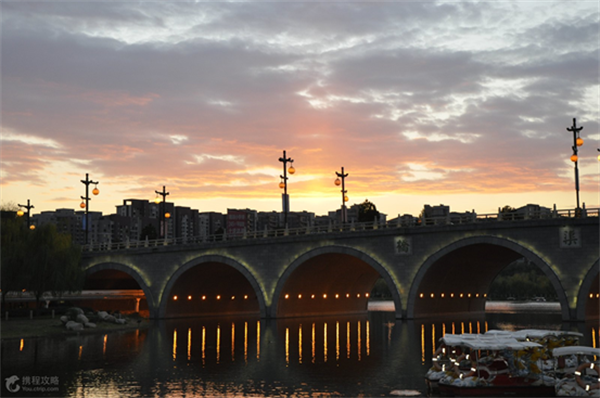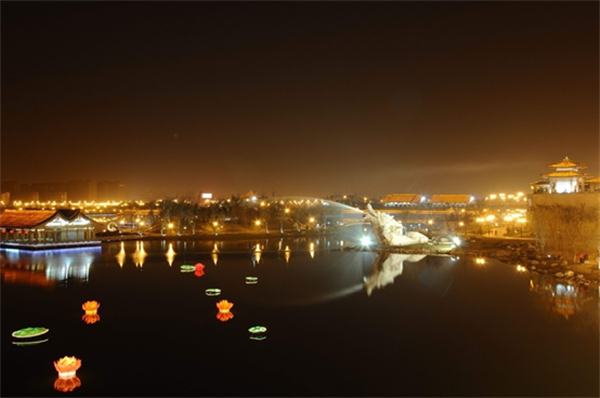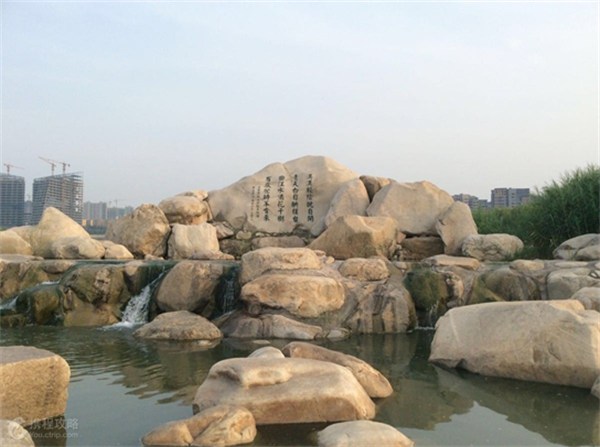Qujiang Lake Relics Park

Information
Ticket: open for free
Opening hours: Winter 9:30~17:30; Summer 9:00~18:00
Best tourist season: all four seasons
Recommended travel time: 3-4 hours
Transportation: Buses No. 22, 224, 212, 504 from Xi’an to Qujiang Lake Dispatching Station (final station); buses No. 715, 933 to Chongyang Square; bus No. 609 to Qujiang Lake Relics Park, and then 2min walk.
Qujiang Lake Relics Park, located to the north of Tang Paradise and south of Mausoleum Site of Second Emperor of Qin Dynasty, covers an area of 1500 mu (approx.100 hectares). In the light of protective development of cultural relics and historic sites like Qujiang Pool Relics of Tang Dynasty and Mausoleum Site of Second Emperor of Qin Dynasty as well as construction of auxiliary urban functions and regional ecological environment, and based on rich tourist and cultural resources and humanist traditions, the restorative construction of some historic and cultural landscapes such as Qujiang River South Lake, Qujiang River Recreation, Hanwu Spring, Yichun Garden and Phoenix Pool has been carried out to represent landscape pattern of “waters pervading through overlapping green forest and woods” in Qujiang area and construct comprehensive urban ecological and leisure and entertainment area integrating eco-environment reconstruction, sightseeing and entertainment and modern business conference based on abundant tourism culture resources and humanistic tradition.
The Qujiang Lake Relics Park is generally designed by Mr. Zhang Jinqiu, renowned master architect. Covering 471mu, it is built on the original location of Qujiang Pool on 1 July, 2008. From north to south stretch as long as 1088m and vary in width from west to east with the widest part is 552m. the Pool is divided into upper and lower parts.

Qujiang Lake Relics Park, as an open urban ecological culture park that integrates historical and cultural protection, ecological gardens, landscapes, leisure tourism, folklore inheritance and art display, is provided with various sculptures everywhere in the park, for instance, lawn, square, slope, waterfront or even in the water, representing social life in Tang Dynasty as a strong atmosphere of Tang Culture. Most of the sculptures are made of bronze or stone in realism style resonating with the visitors.

Major Scenic Spots:
The park, designed by Academician Zhang Jinqiu, is divided into 8 scenic areas with Qujiang River waters as the center and exit of scenery of floating wind cup along winding water of Qujiang River as the boundry: Hanwu Spring, Artists’ Home, Qujiang Pavilion, Trestle of Emperor Xuanzong, Yuejiang Storied Building, Yanbo Island, Yunshao Residencence and Changguan Storied Building.

Entrance
Along the Tang Dynasty Wall Relics to the southeast corner is the west entrance of Qujiang Lake Relics Park. Looking into the distance of Fairy Island in the center of the lake, the lotus colonnade along the Fairy Island in the glistening light of waves looks like a blooming lotus flower. Looking farther, the Yuejiang Storied Restaurant amid willows at south bank of Qujiang Lake leaps to the eyes together with fluttering wine flag while the willow dyke, fragrant flowers and glistening lake are real lures to tourists. The quick-tempered tourists may drive to the restaurant by way of Qujiang Lake West Road towards the south entrance of the park whereas, but has missed out on beautiful sceneries along the north-south direction.
Appreciate flowers in spring, view willow dyke, watch moon in autumn and relish snow in winter. Needless of impatience, learning from luminaries and ladies in flourishing Tang Dynasty, savor prosper and decline in ancient and modern times. In review of the Flourishing Kaiyuan Reign Period in Tang Dynasty, fragrant carriages and precious horses emptied out of from city gate to Qujiang Lake Side. Even the sentimental poet gasped “sunset infinite good” here. Nowadays Qujiang Lake Relics Park still lives up to the ancient views in Tang Dynasty. The vast garden and winding waters embraces tourists recalling the former heyday and representing the ancient capital sight.
Courtyard
Strolling along the ring road of lake bank from the entrance, on the left is the vast lake waters and on the right is the scattered hills and woods. Before long, several courtyards in the woods pleasantly surprise visitors. The sparse ancient pines, tall and straight gingko and gnarled peach trees embellish the yards, worthy of the name Woodland Home. These are 9 two-story buildings in Tang style with classic names of tunes respectively: tune of Breeze through Pines, Silk Washing Stream, Waves Sift Sand, Fragrance Filling the Courtyard, Prelude to Water Melody, Immortal at Riverside, Charm of Singer, Dreaming of Qin Maiden and Water Dragon Chant.
In the courtyard, tourists can enjoy show of Shaanxi Opera, Chinese shadow puppetry and Fengxiang Clay Sculpture. One of the courtyard even is a small museum exhibiting Qujiang Relics discovered in archaeological excavation, including cultural relics from the Neolithic Age to Ming and Qing Dynasties which have witnessed the prosper and decline of Qujiang in more than 2000 years.

Qujiang Pavilion
After visiting the courtyards keeping Shaanxi cultural relics, ramble in peaceful and elegant woods, unconsciously reaching to Qujiang Pavilion in the landscape of water birds playing on water. In the two-story pavilion in ancient style stands by lake side, fresh breeze blows gently from water bringing happiness and pleasure to visitors. One may meditate on the past, inscribe a poem or singing a song, as one like. Several people howl Shaanxi opera at times, keyed-up tunes echoing to Quajiang park in the warm sun and the gurgling water seems also responding to the free and unfettered mind of visitors.
Yuejiang Tower
Yuejiang Tower, the highest and the largest building at Qujiang Lake, is of 4 stories on the ground and one story underground, as high as nearly 28m. The archaistic architecture style makes it like on a layer of rammed earth foundation. In fact, the inner structure is designed delicately with total area of nearly 1000m2. “Slender grass sways at west and east bank, and wind flag swings in wind. Stored building and platform towers in thin smoke and egrets stand in downstream sand.” On Yuejiang Tower, enjoy a distant view of Qujiang Lake, pondering on the past Flourishing age in Tang Dynasty; or gasp in admiration the water and mountain landscape together with buildings and platforms and challenges the bold and unstrained bosom of poetic genius Li Bai. Yuejiang Building has combined the function of restaurant and sightseeing building together, enabling experiencing the temperament and interest of luminaries in Tang Dynasty inditing while drinking at high building. Looking back to south on the building, outside the south gate is Yichun Garden Relics, the imperial garden in Qin Dynasty; overlooking to the north bank of Qujiang Lake is Tang Wall Relics. The renowned Qin garden and Tang Wall converge together at the same time like a dream or a picture. When night falls, the golden light outlining Yuejiang households are more charming. The bright Yuejiang households reflects in lake in the background of mountains, grass, trees blurry in the dim light of night, representing shimmering waves just like gold spilled in lake, inebriating visitors and tourists.
Central Fairy Islands
Hills fluctuate on the island echoes the high bank of 10m to the east. Amounting to the island via 30m long wooden bridge, the path winds along hills and roads by waterside are wide and open. There are three open garden buildings for tourist lingering and fishing platform is provided for angling. Lotus flowers are planted surrounding the island, as “ten miles of lotus flowers covering Qujiang Lake” described by Han Yu, a literary giant in Tang dynasty. The island possesses a natural grace of “fair” atmosphere away from the secular world. Wooden bridge leading ways to island, the group of architecture combines with hills, lake, flowers, trees and grass, with the lotus colonnade as one of the most important component, in pursuit of natural interest and sentiment. “Waterside pavilion is to construct scenery by virtue of waterside or flower with the form adapting to the landscape.” Lotus reflection stirred by paddle and bamboo bridge shrouded in the lotus flower fragrance is the portrayal of Lotus Fragrance Waterside Pavilion.
Yunshao Residencence
Yunshao Residence, built along bank of lake, is seated in the east bank of the lake at height. Ascending to Shangsi Square at top of Yunshao Residence is a panoramic view the beautiful lake landscape.

Art Home
Art Home are buildings with classic names of tunes respectively: tune of Breeze through Pines, Silk Washing Stream, Waves Sift Sand, Fragrance Filling the Courtyard, Prelude to Water Melody, Immortal at Riverside, Charm of Singer, Dreaming of Qin Maiden and Water Dragon Chant.

Historical development
Qujiang, famed tourist attraction in Tang Dynasty, is located in the southeast of Chang’an City in Tang, named after winding waters. First Emperor of Qin Dynasty built imperial villa “Yichun Courtyard”; in Han Dynasty channel was excavated here plus building “Yichun Rear Garden” and “Leyou Garden”. In Sui Dynasty when the city named as “Daxing”,here was excavated into lake. Emperor Wen of Sui Dynasty named the lake as “Lotus Lake” and the garden as “Lotus Garden”. In the era of Emperor Xuanzong in Tang Dynasty, the lake name was reverted back to “Qujiang Lake”. As recorded, in the same era, water was diverted from south out of city via Huang Channel to Qujiang River and additionally built pavilions and buildings to Lotus Garden, which occupied one lane area in southeast of the city and further sticking out of the city. The garden, surrounded by enclosure, covered an area of about 2.4 square kilometer.
Qujiang Lake, started from Qin and Han Dynasty and thrived in Sui and Tang Dynasty, is an Chinese ancient classical garden seasoned over thousands years. Qujiang in Qin Dynasty was a natural pond named as Gaizhou, where built a renowned imperial villa—Yichun Palace. In the era of Emperor Wu in Han Dynasty, on account of its wide and vast expanse of waters, zigzag bank and “shape like Guangling River”, it was renamed as “Qujiang River”. In Sui Dynasty, Daxing City was built and Qujiang was included into the city, renamed as “Lotus Lake”. In Tang Dynasty, massive architecture works were initiated by excavating Huang Channel, opening imperial garden and building double city wall, constructing Greater Wild Goose Pagoda and erecting new city gates so that Qujiang Lake became a tourist attraction covering thousands mu waters and famous in ancient China at that time. Stories and legends of “floating wind cup along winding water of Qujiang River”, “name inscribed on the Pagoda of the Wild Goose as attained doctor’s degree”, “Banquet for champions of Civil Servant Examination in Apricot garden” and “Cool Cave Story” have promoted the Qujiang’s fame of long cultural tradition. At the end of Tang Dynasty, due to wars and insurrection, palace collapsed and lake dried at Qujiang, which was later cultivated into farmland and garden landscape no longer existed. In AD July, 2007, Xi’an municipality has decided to invest heavily in Qujiang Lake Relics park by Qujiang New District, a large open garden ecological works of 1500mu as planned, integrating historical culture, relics protection, urban entertainment and leisure based on exploration of Qujiang historical water system and relics. Qujiang Lake Relics Park, as an significant work of Xi’an “imperial city renaissance plan”, perfectly represents magnificent historical prosperity and is be honored as the construction model combining ancient times and nowadays, harmony between human being and nature by manifesting power and prestige in Qin Dynasty, inheriting culture of Sui and Tang Dynasties with stretches of waters across land.

Landscape in the park
The entire lake covers 0.7 square kilometers in circuitous shape of long in south and north direction and narrow in east and west direction. In the past, at both banks of Qujiang, palaces links in an unbroken line, pavilions and buildings fluctuates along terrain amidst clouds of weeping willow and flowers. It was a famous tourist attraction in Chang’an city of Tang Dynasty, in particular at the prosperous age, as nobles and ladies heading to Qujiang with carriages, horses and attendants for sake of holding banquet and enjoying dance and singing performances in gaily-painted pleasure boats in Qujiang. The candidates in the highest imperial examinations after hearing the successful news also hang out at Qujiang in clusters for banqueting with binge drinks in pursuit of spree. That is the so-called “floating wind cup along winding water of Qujiang River”, one of the eight sceneries of Chang’an. Besides, at festivals of “Shangsi (3rd March in Chinese lunar calendar)” and “Zhongyuan (15th July in Chinese lunar calendar)”, nobles of Tang get together here for banqueting which attracted local residents to watch the events, becoming the bianual events here. After Anlushan Rebellion, most of the buildings at both sides of Qujiang were destroyed while only Ziyun Building and Caixia Pavilion was slightly repaired in 9th year of Tang Dahe Era. At the end of Tang and wartime in the wakes, all of the palaces and buildings were damaged, channels dried and Qujiang turned out to be farmland. The Qujiang of viridity waves, green willows, red flowers only left fluctuant banks, winding channels, traces of river flow and relics of Ziyun Building. Emperor Xuanzong of Tang held two times of banquets to senior officials annually and successful candidates in the highest imperial examinations swarmed to Qujiang for banqueting, wines and spree as one of the eight sceneries in Chang’an—“floating wind cup along winding water of Qujiang River”.
Qujiang Lake Relics Park, generally designed by Mr. Zhang Jinqiu, renowned master architect, is to restore south lake of Qujiang River, floating wind cup along winding water of Qujiang River, Spring of Han Emperor Wu, Huang Channel Bridge etc. historical cultural landscapes and represent landscape pattern of “waters pervading through overlapping green forest and woods” in Qujiang area based on surrounding abundant tourist resources.
The accomplished Qujiang Lake Relics Park will form urban ecological sightseeing belt together with Qujiang Cool Cave Heritage Park, Second Emperor of Qin Dynasty’s Mausoleum Relics Park and Tang City Wall Relics Park.


